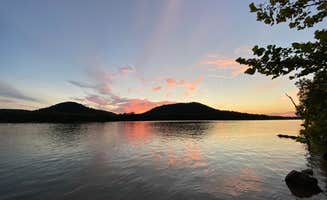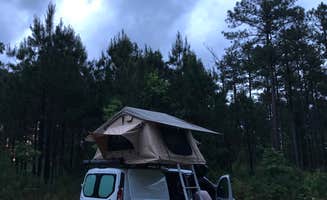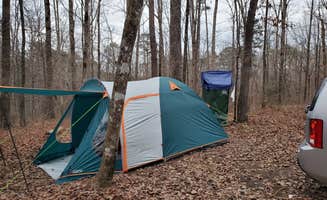Bankhead National Forest offers numerous dispersed camping options near Cullman, Alabama. Located in the southern Appalachians, the forest encompasses 181,230 acres with elevations ranging from 700 to 1,200 feet. The terrain features steep sandstone bluffs, waterfalls, and hemlock-dominated forests creating distinctive microclimates throughout the camping areas.
What to do
Waterfall exploration: Several primitive sites at Wolf Pen Hunters Camp provide access to the Sipsey Wilderness trail system. "Sites are level and clear. A little muddy but it had been raining," notes camper Sam O. The area connects to multiple waterfall hikes ranging from 2-8 miles round trip.
Stargazing opportunities: The remote location of Boondock Dispersed Camping creates excellent night sky viewing conditions. One visitor reported, "The stars were incredible after the moon went down a bit. Lots of bird sounds especially in the morning." Light pollution is minimal throughout the forest's designated camping zones.
Wildlife observation: Early morning and evening hours offer the best wildlife viewing. "Heard some foxes at night," mentions Rhea B. about her December camping experience. The forest hosts white-tailed deer, wild turkeys, and over 100 bird species throughout the seasons.
What campers like
Seasonal flexibility: Winter camping provides distinct advantages at dispersed sites. "We camped here for one night on a road trip in December. We stayed in the second 'middle' spot. It had been raining so the last spot at the end was all muddy," shares one Boondock visitor. The cooler months reduce insect activity and improve visibility through the forest.
Natural soundscape: The more remote camping spots offer natural audio experiences. Charles notes at the circular clearing, "We loved it because there was no chance of hearing any cars and the animal noises were fantastic." Morning birdsong peaks between April and June throughout the forest areas.
Privacy between sites: Forest Service roads create natural separation between camping areas. "Sites are spread out and pretty private," comments Sam O. about Wolf Pen. Most dispersed sites accommodate 1-2 vehicles with adequate space for tents or small trailers.
What you should know
Seasonal preparation: Bug protection becomes essential during warmer months. One camper advises about Boondock Dispersed Camping, "We were glad to have a bug net—probably a necessity for this site!" Ticks are common from March through October, particularly in grassy areas.
Road conditions: Access roads vary significantly by location and recent weather. "Easy drive on paved road until you reach the GPS coordinates (I wouldn't have seen the little gravel road if I hadn't been looking for it)," explains Charles about finding the turn-off. Heavy rain can make some forest roads temporarily impassable for low-clearance vehicles.
Amenities clarity: Confirm exact facilities before arrival as information varies. Amanda C. notes, "If there are toilets and water we never saw them. Just off the main road there is a loop and people were camping in the clearing of the loop." Many sites appear unmarked and facilities mentioned online may be seasonal or no longer maintained.
Tips for camping with families
Site selection strategy: Choose the most accessible dispersed sites with children. "We drove further down the forest road and found a clearing near the dead end and set up camp. It was lovely and peaceful but no amenities at all," describes Amanda C. at Wolf Pen Hunters Camp. Sites nearest to main forest roads typically offer the most level ground.
Hunting season awareness: Verify hunting dates before hiking with children. One experienced camper advises, "Be cautious though to check the hunting seasons if you are planning on hiking though since you want to make sure you can be seen." Alabama's deer hunting season runs October through February, with particular activity on weekends.
Water supply planning: Pack all drinking water needed plus additional for cleaning. The basic nature of these sites means complete self-sufficiency is required. "Closest stores are in Moulton," notes Rhea B., with the town being approximately 20 minutes from most forest camping areas.
Tips from RVers
Size limitations: Most dispersed sites accommodate small to medium RVs only. Timothy K. notes about McDougal Hunt Camp, "If you can get there quick enough there are some pretty good spots to camp and it's free." Arrival by early afternoon on weekdays improves chances of securing suitable spots for vehicles.
Leveling requirements: Bring leveling blocks for uneven forest terrain. "The camping is rustic but the sights are worth it," explains one camper. Most sites require 15-30 minutes of setup time to properly position and stabilize RVs on the natural surfaces.




